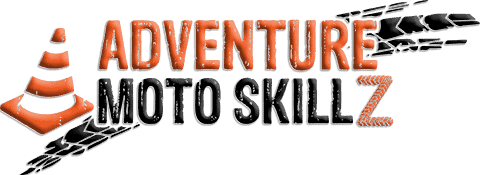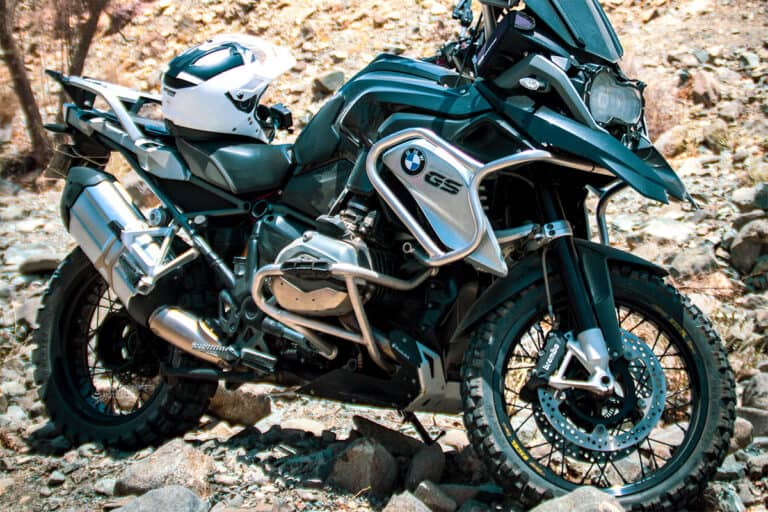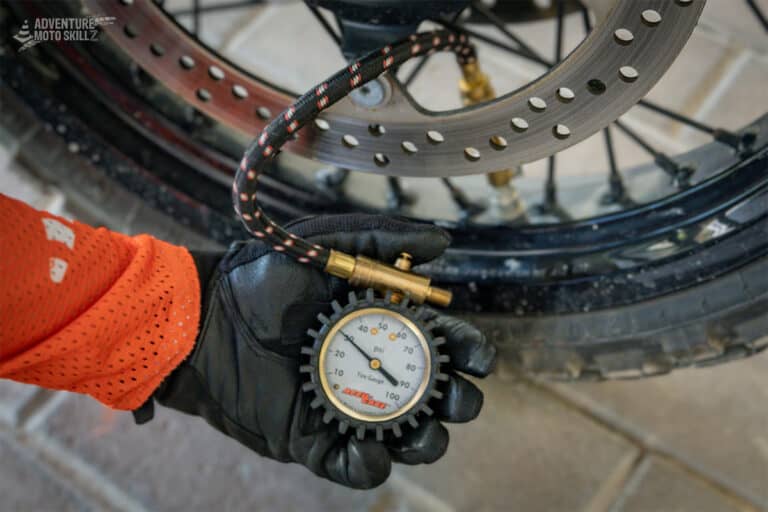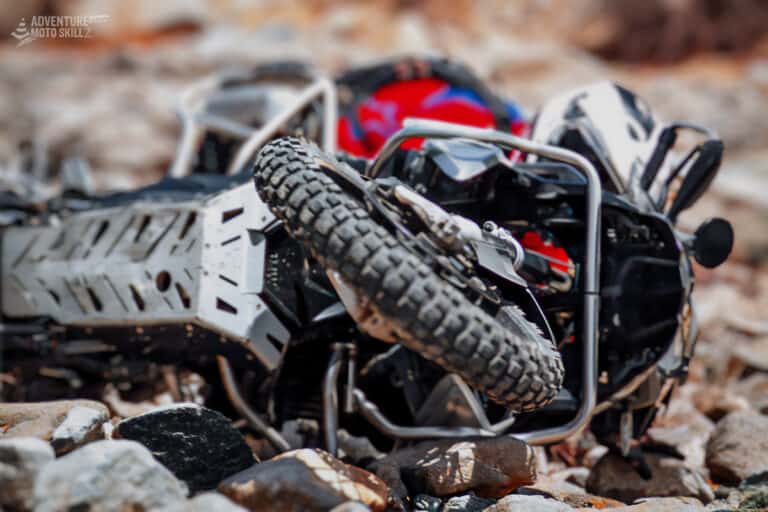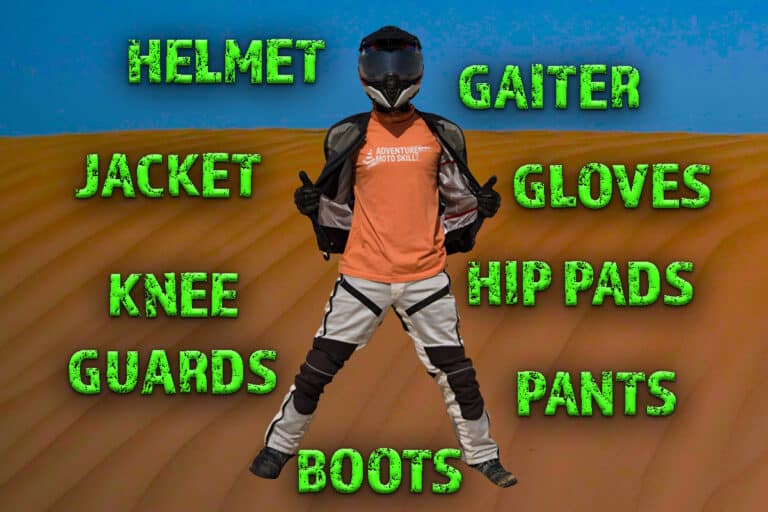Best Guide to ADV Motorcycle Components for Beginners
Now is the time to get to know your bike. This post will review the most critical motorcycle components needed to get you started. This basic understanding of motorcycle parts will help you ride with greater confidence. We have a complete glossary of motorcycle terms here whenever you need it as well.
Riding an adventure motorcycle involves more than just mastering the throttle and clutch. The more you understand the essential components of the motorcycle and how they work, the better you will be able to control it and ride with confidence.

I am not a gearhead and actually started riding later in life (you can read my story here). But by taking the time to learn one new thing about my motorcycle with each ride, my confidence and rider IQ upshifted. So, whether you’re a new or experienced ADV rider, this blog post has something new for you to learn, too!
This post may contain Affiliate Links. Please see our Privacy & Disclosure Policy for more details.

Innovative Motorcycle Tool Sets – Compact & Reliable
Used and recommended by ADVMotoSkillZ
Top 5 “must-know” ADV motorcycle components
Throttle
If it’s GO TIME, then you better understand how the throttle works.
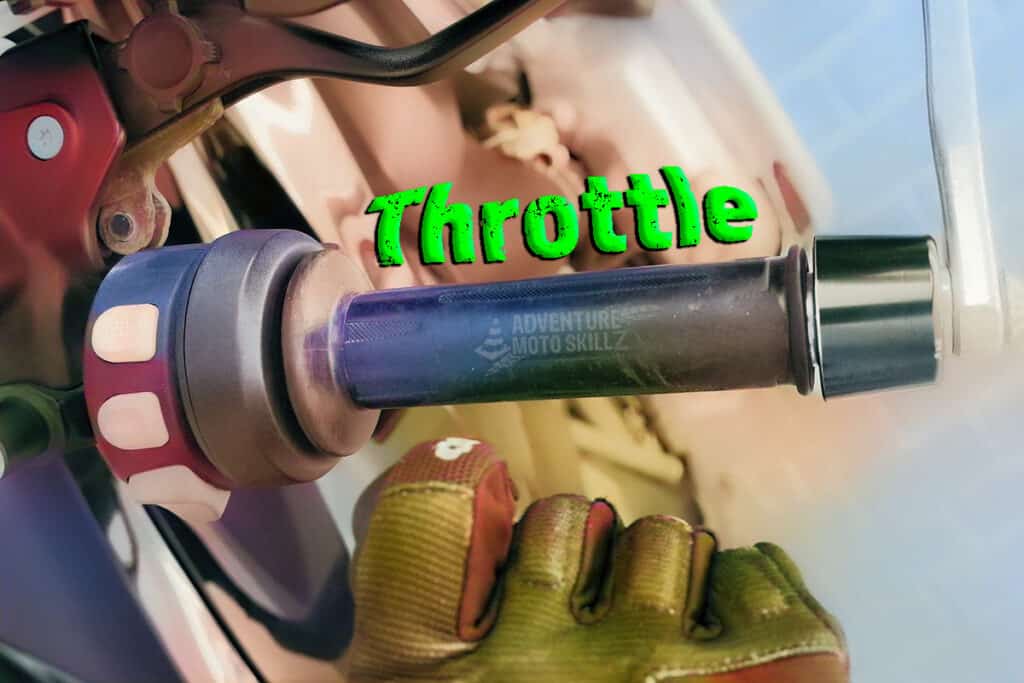
Motorcycle throttles are one of the most important components of your motorcycle. By controlling the amount of air and fuel that enters the engine, it tells the motorcycle how fast to go. The more you twist the throttle towards you, the more air and fuel enter the engine, and the faster your bike will go.
But it’s not only about going fast. When properly used, the motorcycle throttle can give you better control out on the trails. Roll on the throttle slowly for a progressive speed gain or quickly blip the throttle for a quick burst of speed to carry you over a tricky section of the trail. Respect the throttle, and the bike will respect you.
Throttle inputs must be paired with precise clutch work for optimal bike control.
Clutch
The motorcycle’s clutch handles the transfer of power from the engine to the rear wheel. It also provides smooth and consistent power delivery, modulated with the left-handlebar lever.

The motorcycle clutch is located between the engine and the rear wheel. It consists of two main parts: the friction plate and the pressure plate. The friction plate is made of metal and is lined with friction material. The pressure plate is also made of metal and has springs that apply pressure to the friction plate.
The engine’s power is transferred to the rear wheel through the clutch. This happens as the springs in the pressure plate compress and applies pressure to the friction plate. This causes the motorcycle to move forward. If you would like to understand better how the clutch works, check out our Smooth Shifting post here.
To cut power to the engine, simply pull the clutch lever fully in. This lever action releases the pressure on the friction plate and stops delivering engine power to the rear wheel.
The clutch’s friction zone is the area between fully open (when the clutch lever is all the way out) and fully closed (when the clutch lever is all the way pulled in). The ability to properly feather the clutch within the friction zone during a ride is an earmark of a skilled rider.
Front Brake
The motorcycle’s front brake is operated by a hand lever located on the right handlebar.

To apply the front brake, pull the right hand lever toward you with a squeeze of your right hand. Continue to apply pressure to the lever until you feel resistance. This action will engage the motorcycle’s front brake pads and slow down or stop the bike. To release the front brake, simply release the pressure on the hand lever.
The motorcycle’s front brake is typically a hydraulic system and uses either discs or drums to stop the bike. Disc brakes are more common on newer motorcycles and offer better stopping power than drum brakes.
Rear Brake
The motorcycle’s rear is controlled by a foot pedal located in front of the right foot peg. The rear brake on modern bikes is usually a disk brake and works by pressing a set of pads against the spinning disk to slow down or stop the motorcycle.

Dashboard
The motorcycle dashboard provides all the information that riders need during travel. There are different styles of dashboards, but most of them have similar components.
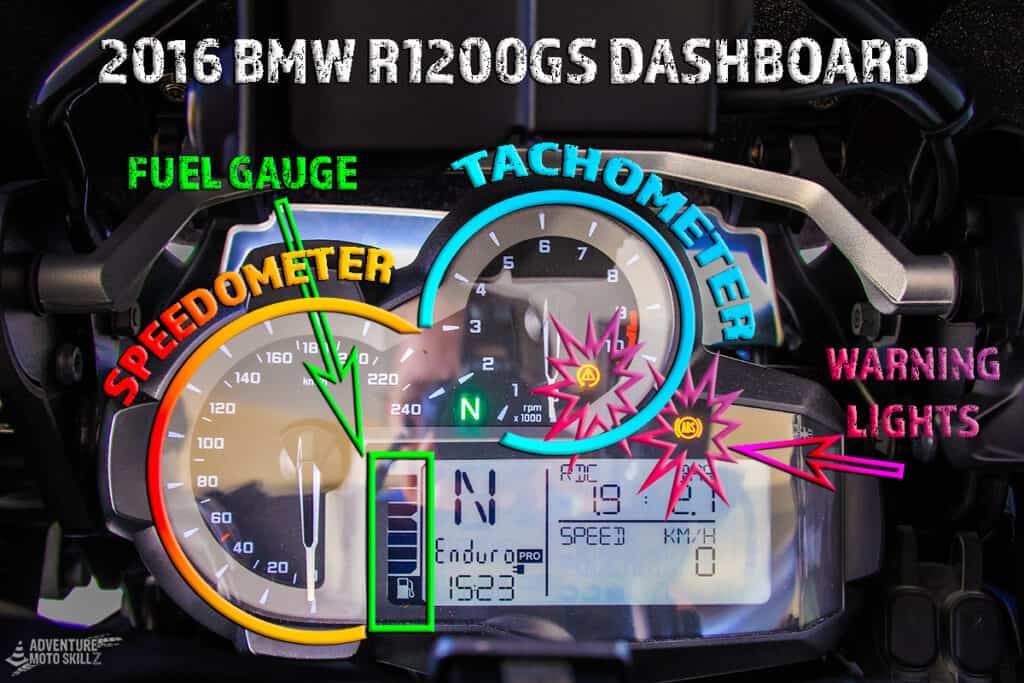
- Speedometer tells riders how fast they are going.
- Tachometer tells riders how many revolutions per minute their engine is making.
- Fuel gauge tells riders how much fuel they have left.
- Odometer tracks how far a motorcycle has traveled over time. Warning lights will appear on the dashboard and should always be respected.
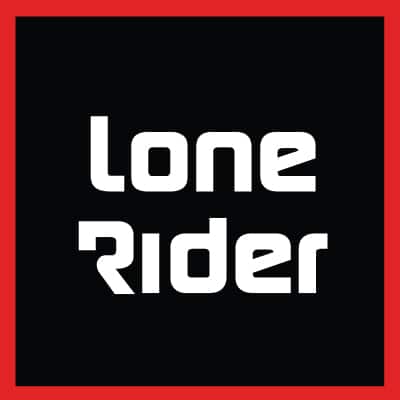
Top-quality gear for your next adventure
Used and recommended by ADVMotoSkillZ
Top “should-know” ADV motorcycle components
Chassis
The motorcycle’s chassis serves as the foundation for the rest of the bike and all its components. The motorcycle frame is typically made from steel tubing, which is welded together to create the motorcycle’s skeleton. This frame provides support for the engine, suspension, and other components.
In addition to the frame, the motorcycle’s wheels, tires, and brakes are also important parts of the motorcycle’s chassis. These components work together to provide a motorcycle with its unique riding characteristics. By understanding your specific bike’s chassis design, riders can better understand how their bike works and how to maintain it.
Engine
The engine is the heart that gives life to a motorcycle. The engine consists of many components, each with a unique purpose and role in the motorcycle’s operation. Each part must work properly for the engine to run smoothly and efficiently. Let’s take a look at some of the motorcycle engine’s key components and how they work together.
- Crankshaft is responsible for converting the reciprocating motion of the pistons into rotational motion. This rotational motion is then transmitted to the motorcycle’s wheels through the use of a chain or belt. The crankshaft is connected to the piston through a connecting rod.
- Cylinder is where the combustion of fuel takes place. This combustion produces energy that is used to power the motorcycle. The cylinder is typically made from cast iron or aluminum and is usually lined with a material that can withstand the high temperatures created by combustion.
- Piston is responsible for converting the energy produced by the combustion of fuel into mechanical energy. This mechanical energy is then used to power the motorcycle. The piston is connected to the crankshaft through a connecting rod.
- Camshaft is responsible for opening and closing the valves that allow air and fuel into the cylinder and exhaust out of the cylinder. The camshaft is connected to the crankshaft and is usually driven by a chain or belt.
- Valve train consists of the valves and the components that actuate them. The valves allow air and fuel into the cylinder and exhaust out of the cylinder. The valve train is initiated by the camshaft.
- Cooling system is responsible for keeping the engine cool. The cooling system consists of a radiator, water pump, and thermostat. The radiator is responsible for dissipating the heat generated by the engine. The water pump is responsible for circulating the coolant through the engine. The thermostat is responsible for regulating the temperature of the coolant.
- Lubrication system is responsible for keeping the engine lubricated. The lubrication system consists of an oil pump and an oil filter. The oil pump is responsible for circulating the oil through the engine. The oil filter is responsible for filtering the oil and removing impurities from the oil.
- The ignition system is responsible for igniting the fuel in the cylinder. The ignition system consists of a spark plug and an ignition coil. The spark plug is responsible for generating a spark that ignites the fuel in the cylinder. The ignition coil is responsible for providing electrical energy to the spark plug.
- Exhaust system is responsible for removing the combustion products from the cylinder. The exhaust system consists of an exhaust manifold, muffler, and catalytic converter. The exhaust manifold collects the combustion products from the cylinder and directs them to the muffler. The muffler is responsible for reducing the noise of the engine. The catalytic converter is responsible for converting the harmful gases in the exhaust into harmless gases.
The motorcycle engine is a vital part of the motorcycle, and it is important to understand how it works in order to keep your bike running smoothly. Take the time to speak with your mechanic on routine maintenance visits and ask them to show you any specific areas they worked on or areas you may need to keep an eye on before your next service.
Transmission
The transmission is responsible for transferring power from the engine to the wheels, and it also helps to control the speed of the motorcycle. There are two types of transmissions that are commonly used on motorcycles: manual and automatic.
Manual transmissions are the most common type of transmission used on motorcycles. They are typically cheaper and easier to maintain, and they also offer the rider more control over the motorcycle’s speed and performance. Manual transmissions usually have four or five gears that the rider can shift between (some even offer a sixth gear).
Automatic transmissions are less common on motorcycles but have become more popular in recent years. Some riders claim that automatic transmissions offer a smooth and more comfortable ride. However, the loss of precise gear control keeps most of these riders on the pavement and off the trails.
Final Drive
The final drive on a motorcycle transmits power from the engine to the rear wheel. It is usually located at the back of the motorcycle and consists of a chain, belt or shaft that turns the wheel.
The final drive ratio is the ratio of gears in the transmission that determines how much power is transmitted to the rear wheel. A higher final drive ratio will result in more power being transmitted to the rear wheel and a higher top speed. A lower final drive ratio will result in less power being transmitted to the rear wheel, therefore a lower top speed.
Most motorcycles have a chain drive, which is a very efficient way to transmit power from the engine to the rear wheel. Shaft drives are less common than chain drives because they are more expensive, but big BMW GS bikes are known for the smoothness of their shaft drive system. Belt drives are typically only found on cruisers and require minimal maintenance.
Wheels
Wheels help to support the motorcycle and keep it stable while riding. The wheel also helps to transfer power from the engine to the ground, which is necessary for moving the motorcycle forward or gaining traction.
There are many different types of motorcycle wheels, each designed for different purposes. Choosing the right motorcycle wheel can help improve the motorcycle’s performance and make it more comfortable to ride. Wheels are made from a variety of materials, including aluminum, steel, and carbon fiber. The type of material used will affect the motorcycle wheel’s weight, durability, and cost.
Tires
Motorcycle tires are purpose-made for the style of riding and bike they will fit on. For example, off-road tires are designed for grip and stability on rough terrain. Racing tires are made for speed and traction on the track. Whilst touring tires provide a balance of comfort and performance for long-distance riding.
When it comes to choosing the right motorcycle tires for your bike, it’s important to consider what type of riding you’ll be doing most often. If you’re mostly riding on paved roads, then touring tires might be your best option. But if you plan on doing some off-roading, you may want to consider getting a set of adventure tires to balance out the traction needs on those off-road excursions.
Front and rear tires are not the same size on your motorcycle. Before ordering new tires, check your rider’s manual for proper sizing for your bike.
Handlebars
There are many types of motorcycle handlebars to choose from, and the best option for you depends on your specific motorcycle and riding style. Some of the most popular options include cruiser, sportbike, touring, and track-day handlebars. Each type of motorcycle handlebar has its own unique set of benefits and drawbacks.
- Cruiser motorcycle handlebars are perhaps the most comfortable type of handlebar available. They provide a relaxed riding position that is easy on your back and arms. Cruiser motorcycle handlebars also give you a great view of the road ahead, making them ideal for long-distance rides. However, they can be difficult to control at high speeds and are not well-suited for aggressive riding styles.
- Sportbike motorcycle handlebars are designed for performance and agility. They offer a more aerodynamic riding position that helps you easily slice through the wind. Sportbike motorcycle handlebars also provide better control and maneuverability, making them ideal for racing and track days. However, they can be uncomfortable for long rides and are not recommended for beginners.
- Touring motorcycle handlebars offer the best of both worlds. They provide a comfortable riding position that is easy on your back and arms while also giving you good control of the motorcycle. Touring motorcycle handlebars are ideal for long-distance rides but can also be used for aggressive riding styles.
- Track-day motorcycle handlebars are designed for maximum control and maneuverability. They offer a very aggressive riding position that puts your weight on the front of the motorcycle. This helps you keep the motorcycle stable through high-speed corners. However, track-day motorcycle handlebars can be uncomfortable for long rides and are not recommended for beginners.
Foot Pegs
The foot pegs are where the rider puts their feet while riding. Many types of foot pegs are available on the market, so it is essential to choose one that best suits your riding style. Aftermarket footpegs offer a variety of features from narrow to wide and rigid to pivoting.
Lights
When it comes to motorcycle lighting, there are three main types of systems: halogen, xenon (HID), and LED.
- Halogen headlights are the most common type found on motorcycles. They use a tungsten filament that is heated by an electric current, which then emits light.
- Xenon (HID) headlights use a gas discharge system to produce light.
- LED headlights are the most recent type of motorcycle headlight. LEDs use semiconductors to convert electrical energy into light.
Suspension
There are three common types of motorcycle suspension systems: the telescopic fork, the swingarm, and the girder. Each has its own advantages and disadvantages, so it’s important to choose the right one for your motorcycle.
- The telescopic fork is the most common type of suspension system. It consists of two forks that extend from the motorcycle’s frame. The forks are connected to the motorcycle’s wheels via springs and shocks. The advantage of this system is that it provides a smooth ride. However, it can be difficult to adjust the suspension if you’re not a mechanic.
- Side note: BMW GS motorcycles have a unique front suspension system called Telelever that separates the two functions of wheel alignment and damping/suspension.
- The swingarm is another type of suspension system. It consists of a single arm that extends from the motorcycle’s frame. The arm is connected to the motorcycle’s rear wheel via a spring and shock. The advantage of this system is that it’s easy to adjust. However, it can provide a bumpier ride than the telescopic fork.
- The girder is the least common type of suspension system. It consists of two beams that extend from the motorcycle’s frame. The beams are connected to the motorcycle’s front and rear wheels via springs and shocks. The advantage of this system is that it’s very easy to adjust the suspension. However, it can provide a bumpier ride than the telescopic fork and swingarm.
Kickstand/Center Stand
The motorcycle’s kickstand supports the bike from the left side and creates a leftward lean when in use. Kickstands are the most common support type found on all street-legal bikes.
Center stands are less common but useful support that connects to the underside of the bike. Center stands are great to use during routine maintenance, tire changes, or long-term bike storage.
We have a detailed post on kickstand and center stand use here.
Air Filter
The air filter’s job is to clean the air before it enters the engine. A dirty air filter can cause all sorts of problems, from decreased performance to engine damage. Check out how I clean my BMW GS air filter here.
Air filters are typically classified according to two criteria: filtration efficiency and dust-holding capacity. The first criterion is a measure of how well the filter removes particulate matter from the airstream, while the second criterion indicates how much particulate matter the filter can hold before it needs to be replaced or cleaned.
- Panel air filters are the most common type of motorcycle air filter. They consist of a frame made of metal or plastic onto which a pleated paper filter is mounted. The pleats increase the paper’s surface area, allowing for greater particulate capture. Panel filters typically have a low initial price but require more frequent replacement than other types of motorcycle air filters.
- Cartridge air filters are similar to panel air filters in that they also have a pleated paper filter element. However, the filter element is enclosed in a metal or plastic housing. This housing helps protect the filter element from damage and makes it easier to remove and replace. Cartridge air filters typically have a higher initial price than panel filters but require less frequent replacement.
- Foam air filters are made of a porous foam material that captures particulate matter as air passes through it. Foam filters can be washed and reused, making them a more economical option. However, they require more frequent cleaning than other motorcycle air filters.
Crash Bars or Engine Guards
These tubular bars attached to the bike’s frame protect the bike in the event of a tip-over or fall. These are a must-have piece of protection for off-road riding.
Hand Guards
Hand guards attach directly to the handlebars and protect the rider’s hand from debris whilst also offering protection to lever arms during tip-over and falls. As a side benefit, well-made metal guards provide a great handhold when lifting a downed bike.
Skid Plate
A skid plate is a piece of metal or plastic that covers the bottom of the motorcycle engine and frame. Skid plates help protect the motorcycle from damage when it slides on the ground or debris kicks up from the trail. Some bikes will come with a skid plate, but aftermarket options are great for customizing your protection to your specific riding needs.

About the Author
Coach Mike is a Certified Off-Road Motorcycle Instructor & founder of ADVMotoSkillZ.
Riding tips from ADVMotoSkillZ reach thousands of international riders daily through social & blogs.
Click here to learn more about Mike’s motorcycle evolution from a Harley road rider to finding his true passion for off-road riding on a BMW 1200 GS.
If you would like to send Mike a quick message or invite him to provide training at your local facility, then visit the contact page here.
